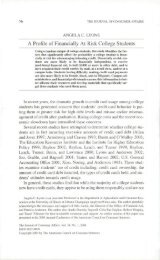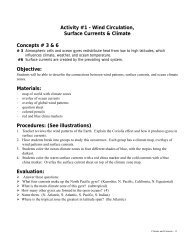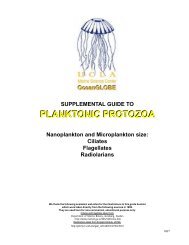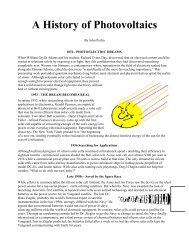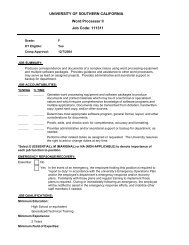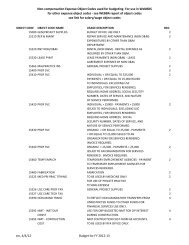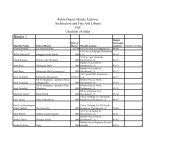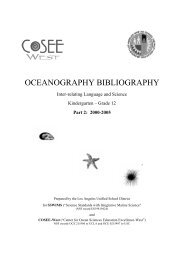Create successful ePaper yourself
Turn your PDF publications into a flip-book with our unique Google optimized e-Paper software.
Characteristics <strong>of</strong> the <strong>Three</strong> Domains <strong>of</strong> Life<br />
Alongside the three-domain system, there exists a six kingdom system <strong>of</strong> <strong>life</strong>, i.e. Archaebacteria<br />
(comprising ancient bacteria), Eubacteria (comprising true bacteria), Protista (comprising onecelled<br />
organisms), Fungi, Plantae, and Animalia. While Archaebacteria and Eubacteria constitute<br />
the Archaea and Bacteria <strong>domains</strong> respectively, Protista, Fungi, Plantae and Animalia together<br />
form the Eukaryote domain <strong>of</strong> <strong>life</strong>. Discussed below are the characteristic traits <strong>of</strong> each <strong>of</strong> these<br />
three <strong>domains</strong> <strong>of</strong> <strong>life</strong>.<br />
Archaea Domain: Archaea are prokaryotic cells which are typically characterized by membranes<br />
that are branched hydrocarbon chains attached to glycerol by ether linkages. The presence <strong>of</strong> this<br />
ether containing linkages in Archaea adds to their ability <strong>of</strong> withstanding extreme temperature and<br />
highly acidic conditions. Extreme halophiles - i.e. organisms which thrive in highly salty<br />
environment, and hyperthermophiles - i.e. the organisms which thrive in extremely hot<br />
environment, are best examples <strong>of</strong> Archaea.<br />
Bacteria Domain: Even though bacteria are prokaryotic cells just like Archaea, their membranes<br />
are made <strong>of</strong> unbranched fatty acid chains attached to glycerol by ester linkages. Cyanobacteria<br />
and mycoplasmas are the best examples <strong>of</strong> bacteria. As they don't have ether containing linkages<br />
like Archaea, they are grouped into a different category - and hence a different domain. There is a<br />
great deal <strong>of</strong> diversity in this domain, such that it is next to impossible to determine how many<br />
species <strong>of</strong> bacteria exist on the planet.<br />
Eukarya Domain: As the name suggests, the Eukaryote are eukaryotic cells which have<br />
membranes that are pretty similar to that <strong>of</strong> bacteria. Eukaryote are further grouped into Kingdom<br />
Protista (algae, protozoans, etc.), Kingdom Fungi (yeast, mold, etc.), Kingdom Plantae (flowering<br />
plants, ferns, etc.) and Kingdom Animalia (insects, vertebrates, etc.). Not all Eukaryotes have a cell<br />
wall, and even if they do they don't contain peptidoglycan as bacteria do. While cells are organized<br />
into tissues in case <strong>of</strong> kingdom Plantae as well as kingdom Animalia, the presence <strong>of</strong> cell walls is<br />
only restricted to the members <strong>of</strong> kingdom Plantae.<br />
Each <strong>of</strong> these three <strong>domains</strong> <strong>of</strong> <strong>life</strong> recognized by biologists today contain rRNA which is unique to<br />
them, and this fact in itself forms the basis <strong>of</strong> three-domain system. While the presence <strong>of</strong> nuclear<br />
membrane differentiates the Eukarya domain from Archaea domain and Bacteria domain - both <strong>of</strong><br />
which lack nuclear membrane, the distinct biochemistry and RNA markers differentiate Archaea<br />
and Bacteria <strong>domains</strong> from each other.<br />
C. CLASSIFICATION: THE THREE DOMAIN SYSTEM<br />
http://faculty.ccbcmd.edu/courses/bio141/lecguide/unit1/3domain/3domain.html<br />
The overall purpose <strong>of</strong> this Learning Object is:<br />
1) to compare the three <strong>domains</strong> <strong>of</strong> cellular organisms found in nature; and<br />
2) to learn which <strong>of</strong> these are prokaryotic and which is eukaryotic.<br />
The Earth is 4.6 billion years old and microbial <strong>life</strong> is thought to have first appeared between 3.8<br />
and 3.9 billion years ago; in fact, 80% <strong>of</strong> Earth's history was exclusively microbial <strong>life</strong>. Microbial <strong>life</strong><br />
is still the dominant <strong>life</strong> form on Earth. It has been estimated that the total number <strong>of</strong> microbial cells<br />
on Earth on the order <strong>of</strong> 2.5 X 10 30 cells, making it the major fraction <strong>of</strong> biomass on the planet.


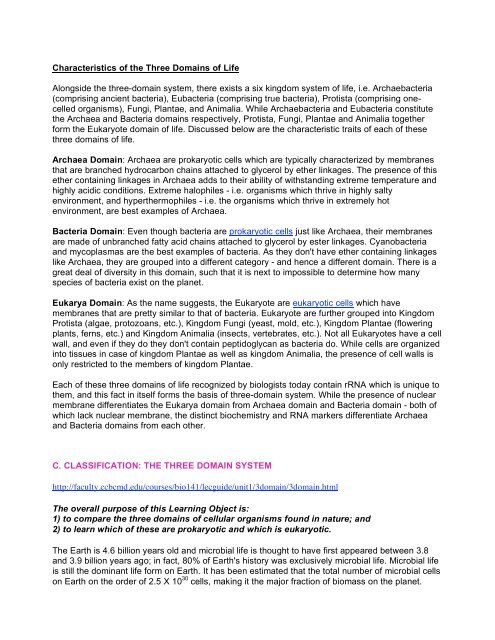
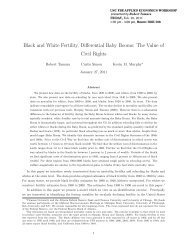

![15. RS 1.003 (RaJsu-yeni - nql?) RS 18.056 (RaJsu-yeni -5'[ ... ])](https://img.yumpu.com/51622603/1/189x260/15-rs-1003-rajsu-yeni-nql-rs-18056-rajsu-yeni-5-.jpg?quality=85)
